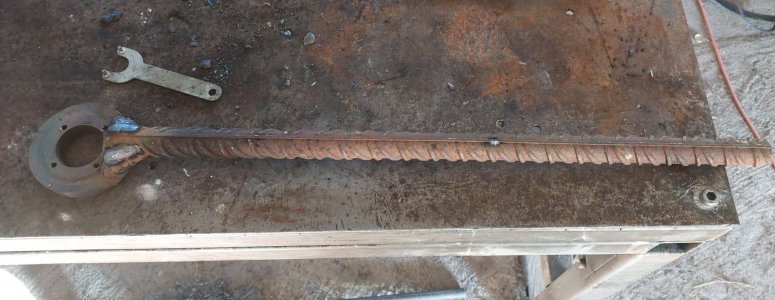In the picture below, a there is a typical angle grinder pin wrench to scale next to my new pin wrench. This is approximately 1inch thick rebar 25in (63cm) long. It is a 4 pin wrench and it absolutely needs all 4 pins to transfer this much torque.
The pin wrench is to be used when a gentle use of huge force is necessary. Especially for adjusting the precision tapered bronze bushing in my surface grinder spindle.
The holes match the pattern in the bushing nut and they are supposed to take cobalt hss 5mm drill shanks as pins (no other material I found will resist the force without deforming, standard bearing roller pins are not long enough)

The ring section uses high strength steel that came from a hydraulic rod from a huge digger (after the hard layer was removed with CBN). The welds are Mig and were made at 300 amps of current with a dual shield wire normally used for structural applications like joining heavy pieces of steel tubing etc. I tried to add as much material as possible.
For those wondering if I have gone completely insane making this wrench to adjust a precision instrument I refer you to my surface grinder spindle restoration thread. It shows a bronze bushing that is whole - not split. For some strange reasons the designers thought deforming the bronze with huge force is preferable to simply making slits in it like typical adjustable bronze bushing.
The original nut has been beaten with hammers to tighten with such force (not by me!) to deform threads a quarter inch from the face! Thankfully the pin holes are very deep and still usable. Also I managed to fix the thread on a lathe. No surprise the machine manual includes "remaking spindle adjusting nuts" as one of the jobs for a "9000 hours of operation service".
The pin wrench is to be used when a gentle use of huge force is necessary. Especially for adjusting the precision tapered bronze bushing in my surface grinder spindle.
The holes match the pattern in the bushing nut and they are supposed to take cobalt hss 5mm drill shanks as pins (no other material I found will resist the force without deforming, standard bearing roller pins are not long enough)

The ring section uses high strength steel that came from a hydraulic rod from a huge digger (after the hard layer was removed with CBN). The welds are Mig and were made at 300 amps of current with a dual shield wire normally used for structural applications like joining heavy pieces of steel tubing etc. I tried to add as much material as possible.
For those wondering if I have gone completely insane making this wrench to adjust a precision instrument I refer you to my surface grinder spindle restoration thread. It shows a bronze bushing that is whole - not split. For some strange reasons the designers thought deforming the bronze with huge force is preferable to simply making slits in it like typical adjustable bronze bushing.
The original nut has been beaten with hammers to tighten with such force (not by me!) to deform threads a quarter inch from the face! Thankfully the pin holes are very deep and still usable. Also I managed to fix the thread on a lathe. No surprise the machine manual includes "remaking spindle adjusting nuts" as one of the jobs for a "9000 hours of operation service".
